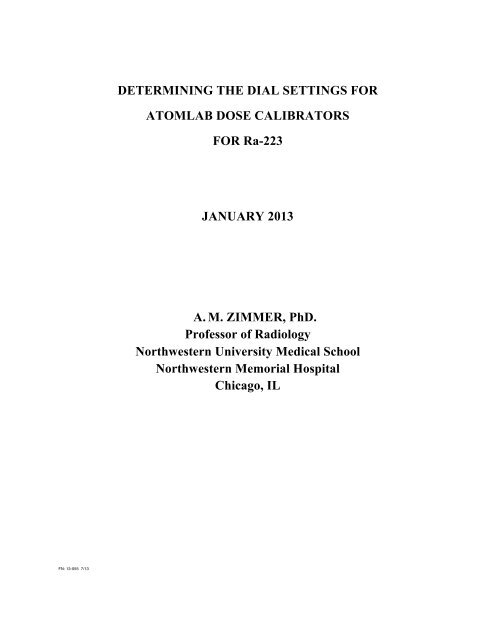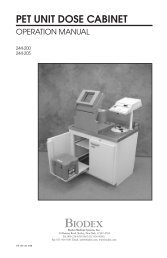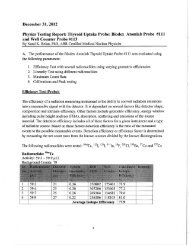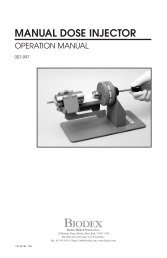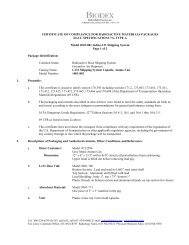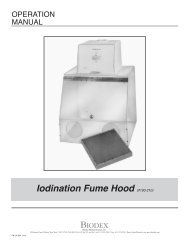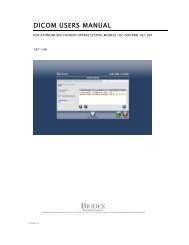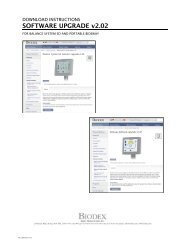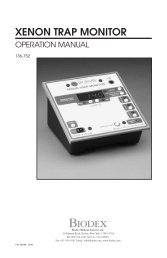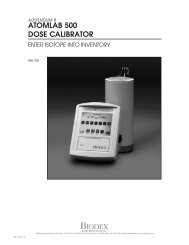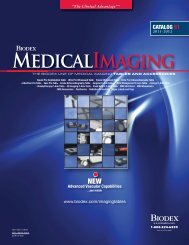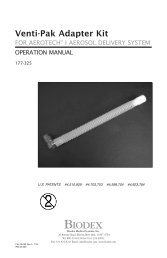Determining the Dial Settings for Atomlab Dose Calibrators ... - Biodex
Determining the Dial Settings for Atomlab Dose Calibrators ... - Biodex
Determining the Dial Settings for Atomlab Dose Calibrators ... - Biodex
- No tags were found...
Create successful ePaper yourself
Turn your PDF publications into a flip-book with our unique Google optimized e-Paper software.
DETERMINING THE DIAL SETTINGS FORATOMLAB DOSE CALIBRATORSFOR Ra-223JANUARY 2013A. M. ZIMMER, PhD.Professor of RadiologyNorthwestern University Medical SchoolNorthwestern Memorial HospitalChicago, ILFN: 13-055 7/13
A. Michael Zimmer, PhD., Northwestern University Medical School, Northwestern Memorial Hospital,Chicago, IL received a Ra-223 Standard from Europe as part of <strong>the</strong>ir participation in clinical trials.This standard was used to determine <strong>the</strong> correct dial value <strong>for</strong> two different models of <strong>Dose</strong> <strong>Calibrators</strong> –<strong>Atomlab</strong> 100 and <strong>Atomlab</strong> 500.Three of each of <strong>the</strong> dose calibrator models were used <strong>for</strong> <strong>the</strong> determination (referred hereafter to as DC1,DC2 and DC3.)Standard: Traceable Ra-223 Standard, 134 µCi in a vial, calibrated <strong>for</strong> December 31, 2012I. The <strong>Atomlab</strong> 100 Standard <strong>Dial</strong> <strong>Settings</strong> <strong>for</strong> Vial Determination<strong>Biodex</strong> <strong>Atomlab</strong> 100 <strong>Dose</strong> Calibrator Using A VialCalculated <strong>Dial</strong> Setting 28.0 Reading 228 µCiDC1 <strong>Dial</strong> Setting 16.5 Reading 134.6 µCiDC2 <strong>Dial</strong> Setting 16.2 Reading 134.5 µCiDC3 <strong>Dial</strong> Setting 15.9 Reading 134.1 µCiPercent variance between lowest and highest reading using DC3 was3.7%.Geometry: Placing vial in lowest dipper position and <strong>the</strong> syringedipper location resulted in an error of 0.3% using DC3.The <strong>Atomlab</strong> 500 Standard <strong>Dial</strong> <strong>Settings</strong> <strong>for</strong> Vial Determination<strong>Biodex</strong> <strong>Atomlab</strong> 500 <strong>Dose</strong> Calibrator Using A VialDC1 <strong>Dial</strong> Setting 17.2 Reading 134.5 µCiDC2 <strong>Dial</strong> Setting 17.7 Reading 134.0 µCiDC3 <strong>Dial</strong> Setting 16.6 Reading 134.3 µCiPercent variance between lowest and highest reading using DC3 was6.2%.Geometry: Placing vial in lowest dipper position and <strong>the</strong> syringedipper location resulted in an error of 0.4% using DC2.II.The Standard <strong>Dial</strong> <strong>Settings</strong> <strong>for</strong> Syringe DeterminationRa-223 calibration in syringe (5ml B-D syringe). Exactly 1.0, 2.0, 3.0, 4.0 and 5.0ml from <strong>the</strong> traceablestandard and changing <strong>the</strong> calibration setting to reflect <strong>the</strong> activity withdrawn.<strong>Biodex</strong> <strong>Atomlab</strong> 100 <strong>Dose</strong> Calibrator <strong>for</strong> SyringeSyringe calibration was per<strong>for</strong>med on DC3. Results are graphically expressed in <strong>the</strong> attached graph. <strong>Dial</strong>values ranged from 15.9 <strong>for</strong> 1.0ml volume to 16.9 <strong>for</strong> <strong>the</strong> 5.0ml volume. The percent difference from <strong>the</strong>lowest to <strong>the</strong> highest dial setting, using <strong>the</strong> 1.0 ml as <strong>the</strong> standard, was 6.2%.<strong>Biodex</strong> <strong>Atomlab</strong> 500 <strong>Dose</strong> Calibrator <strong>for</strong> SyringeSyringe calibration was per<strong>for</strong>med on DC2. Results are graphically expressed in <strong>the</strong> attached graph. <strong>Dial</strong>values ranged from 17.7 <strong>for</strong> 1.0ml volume to 18.8 <strong>for</strong> <strong>the</strong> 5.0ml volume. The percent difference from <strong>the</strong>lowest to <strong>the</strong> highest dial setting, using <strong>the</strong> 1.0ml as <strong>the</strong> standard, was 6.3%.
III. ConclusionBased on <strong>the</strong> readings <strong>for</strong> <strong>the</strong> three <strong>Atomlab</strong> 100 <strong>Dose</strong> <strong>Calibrators</strong> and also <strong>the</strong> three <strong>Atomlab</strong> 500 <strong>Dose</strong><strong>Calibrators</strong> <strong>for</strong> both vial and syringe dial values, a mean value of 16.7 <strong>for</strong> <strong>the</strong> <strong>Atomlab</strong> 100 and 17.8 <strong>for</strong><strong>the</strong> <strong>Atomlab</strong> 500 would be appropriate <strong>for</strong> both vial and syringe settings. This would result in errors ofless than 5% when measuring both vials and syringes (5ml syringe with maximum volume of 5.0ml).<strong>Atomlab</strong> 100 <strong>Atomlab</strong> 500ml <strong>Dial</strong> ml <strong>Dial</strong>1 15.9 1 17.72 16.1 2 17.93 16.4 3 18.14 16.6 4 18.45 16.9 5 18.8


